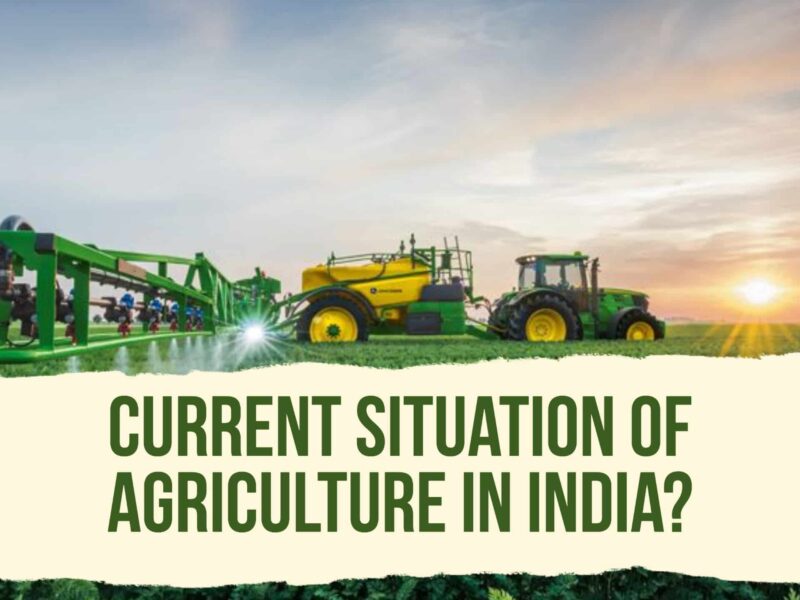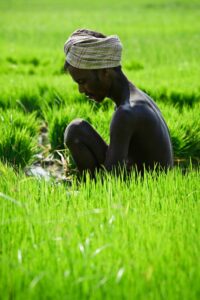Current situation of agriculture in India in 2023
INTRODUCTION
India is one of the major players in the agriculture sector worldwide and it is the primary source of livelihood for ~55% of India’s population.
India boasts the world’s most extensive population of cattle, primarily buffalo.
Additionally, it leads in terms of the vast areas dedicated to cultivating wheat, rice, and cotton, while also standing out as the largest global producer of milk, pulses, and spices. India is also the world’s second-largest producer of fruit, vegetables, tea, farmed fish, cotton, sugarcane, wheat, rice, cotton, and sugar. The importance of agriculture in India cannot be overstated.
As the country has the second largest agricultural area in the world and provides employment opportunities for nearly half of India’s population. Thus, farmers are an indispensable part of this sector, ensuring our sustenance and well-being.
Priority Areas for Support In cultivation.
Here are significant strides and transformative investments in the realm of cultivation:
1 Government has set up a special fund called the Food Processing Fund (FPF) of approximately US$ 265 million in the National Bank for cultivation and Rural Development.
(NABARD) for extending affordable credit to designated food parks and food processing enterprises in the designated food parks.
2.India is also the second-largest producer of wheat, rice, cotton, sugar, farmed fish, fruit, vegetables, tea, and other agricultural products in the world.
The livestock sector, primarily due to dairy, contributes over a quarter of agricultural GDP and is a source of income for 70% of India’s rural families, mostly those who are poor and headed by women.
3. The sector has also recorded a sharp increase in investments with a cumulative FDI inflow of US$ 2,708.72 million. Between April 2000-December 2022.
4.The Indian government intends to introduce Kisan Drones in 2022. For use in land record digitization, spraying insecticides and nutrients, and crop assessment.
5. India’s agricultural and processed food products exports stood at US$ 9,598 million in FY23 (April-July 2022), up by 30%
6. Improving Water Resources and Irrigation/Drainage Management:
Agriculture is India’s largest user of water. The necessity for comprehensive river basin and sector-wide coordination and management of water resources becomes more evident due to the escalating competition among industries, households, and agriculture for water. With the rise in urban and other water demands, there is a projected decrease in the amount of available water for irrigation.
MARKET SIZE
The main driver of the industry’s growth is India’s rapid population increase. This is reinforced by the rising income levels in both rural and urban areas, driving a surge in demand for agricultural products throughout the country.
the Indian agricultural sector is predicted to increase to US$ 24.1 billion by 2025. Indian food market is the world’s sixth largest, with retail contributing 70% of the sales.
India exported $43.37 billion worth of processed food and agricultural products in FY23 (April 2022–January 2023).
As per Second Advance Estimates for 2022-23 (Kharif only), total food grain production in the country is estimated at 153.43 million tones. At current prices, agriculture and allied sectors account for 18.3% of India’s GDP (2022-23).
Exports of marine products stood at US$ 7.4 billion.
10.2 billion US dollars worth of rice was export.
Buffalo meat exports stood at US$ 2.88 billion.
Sugar exports stood at US$ 5.28 billion.
Tea exports stood at US$ 759.96 million.
Coffee exports stood at US$ 1.01 billion.
GOVERNMENT INITIATIVES / World Bank Support
With some $5.5 billion in net commitments from both IDA and IBRD, and 24 ongoing projects, the World Bank’s agriculture and rural development program in India is by far the In terms of dollar value, this initiative is the largest for the bank globally.
In the Union Budget 2022-23:
The Department of Agriculture, Cooperation, and Farmers’ Welfare has received a budget of Rs. 1.24 lakh crore ($15.9 billion).
The Ministry of Agricultural Research and Education has received US$1.1 billion or 8,514 rupees.
The Agricultural Technology Management Agency (ATMA) programme, aimed at educating farmers, has been established in 704 counties in 28 states and 5 federations.
Under the credit related subsidy component of the PM Formalization of Micro Food Proc approved in the nation.
IDA funding for the Prime Minister’s National Rural Roads Program
(PMGSY) will improve rural connectivity, and self-help groups (and SHG associations), water user associations, and producer organizations will link the rural poor and small farmers.
Access to public services through cooperative action.
total of 27,003 loans were approved under the credit-linked subsidy component of the PM Formalization of Micro Food Processing Enterprises Scheme (PMFME).
For the rural poor and small farmers through the formation of self-help groups (and SHG associations), water user associations, and agricultural producers
The Indian Prime Minister launched the Pradhan Mantri Kisan Samman Nidhi Yojana (PM-Kisan) and transferred Rs.
2.021 billion rupees ($284.48 million) to the bank accounts of nearly 10 million beneficiaries. In the Union Budget 2021-22,
Rs. An allocation of 65,000 crore rupees was made for the Pradhan Mantri Kisan Samman Nidhi program.
To ensure that cooperatives benefit from digital technology, the Government of India will allocate Rs. 2,000 crore ($306.29 million) for the computerization of the Primary Agricultural Credit Society.
This would enable inclusive, farmer-centric solutions through applicable crop planning and health information services.
Improved access to agricultural inputs, credit and insurance, crop estimation assistance, market information, and support for startups and the expansion of the agricultural technology sector.
ROAD AHEAD
The share of agriculture and allied sectors in the total gross value added of India was 18.8 percent in 2021-2022.
But while the share of agriculture has been declining in the overall gross value added of India. It continues to grow in absolute terms and employees almost 49 percent of the total households in 2022 and 2023.
“The agricultural earnings are poor for a number of reasons, including low productivity in many areas of the nation, irrigation coverage that is still only approximately 49.5 percent.
As well as some years when the prices of agricultural commodities are too low, which leaves the farmers with insufficient revenue. Therefore, the government has been attempting to lure individuals away from agriculture and into other economic areas.
Although we haven’t had much success doing that, I still believe we can. Under the PM Matsya Sampada Yojana.
The national government will aim to invest US$ 9 billion in the fisheries sector over the next five years.





